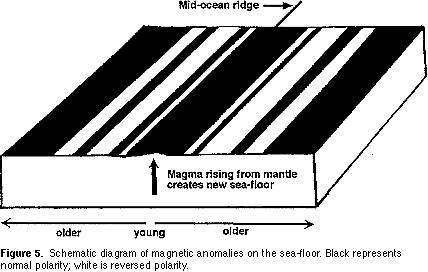New oceanic crust is magnetized as it forms and then it moves away from the ridge in both directions.
Magnetic striping of ocean floor gives relative ages.
A theoretical model of the formation of magnetic striping.
The survey data was used to create three dimensional relief maps of the ocean floor and by 1953 american oceanic cartographer marie tharp had created the first of several maps that revealed the presence of an underwater mountain range.
Plate tectonics from the late latin.
Magnetic stripes are the result of reversals of the earth s field and seafloor spreading.
Tectonicus from the ancient greek.
It is called a geomagnetic reversal.
1953 marie tharpe recognizes mid ocean ridge spreading.
More important because the presence of magnetite gives the basalt measurable magnetic properties these newly discovered magnetic variations provided another means to study the deep ocean floor.
Paleomagnetism or palaeomagnetism in the united kingdom is the study of the record of the.
Scientists can determine the age of the seafloor by examining the changing magnetic field of our planet.
This has happened many times throughout earth s history.
Every once in a while the currents in the liquid core which create the earth s magnetic field reverse themselves.
When scientists studied the magnetic properties of the.
The models show a ridge a about 5 million years ago b about 2 to 3 million years ago and c in the present.
Coast and geodetic survey ship pioneer in a joint project with the u s.
Pertaining to building is a scientific theory describing the large scale motion of seven large plates and the movements of a larger number of smaller plates of earth s lithosphere since tectonic processes began on earth between 3 3 and 3 5 billion years ago.
The discovery adds a key element to the theory of plate tectonics.
This distortion was recognized by icelandic mariners as early as the late 18th century.
1963 hot spots defined.
Navy and the scripps institution of oceanography tows the first marine magnetometer and finds magnetic striping on the seafloor off the west coast.
In 1966 vine and matthews and also morley working independently compared these known ages of magnetic reversals with the magnetic striping pattern found on the ocean floor.
Shortly after the conclusion of world war ii sonar equipped vessels crisscrossed the oceans collecting ocean depth profiles of the seafloor beneath them.
1962 harry hess names spreading ridges 1963 magnetic striping of ocean floor gives relative ages.

